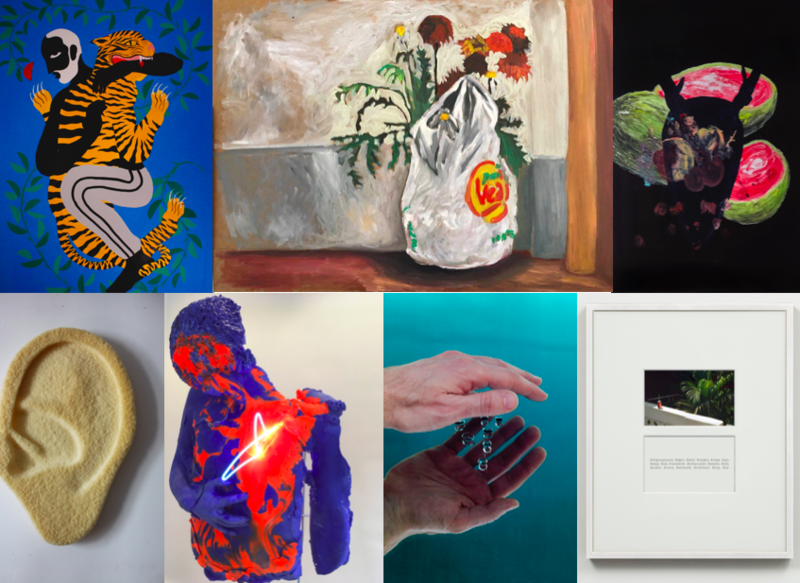The selected works of the Visual Arts Contest of the FNA Argentina were announced
The Visual Arts Prize of the FNA is aimed at Argentine and foreign artists who legally live in Argentina with the aim of recognizing and promoting national production.

Three artistic categories are established: Painting / Drawing; Sculpture / Object; Photography and consists of two instances: in the first, those works that will participate in the exhibition will be selected anonymously in March 2018 at the National House of the Bicentennial in CABA. Once the chosen works are received, the authors will be revealed to the jury to continue with the second instance of awarding.
The juries were Juan Astica, Gachi Hasper and Mónica Millán for the Painting / Drawing section, Diego Bianchi, Jorge Gamarra and Laura Valdivieso for the category of Sculpture / Object and Rosana Schoijett, Viviana Usubiaga and Gabriel Valansi for Photography.
The winners of the Visual Arts category are:
Maria Dolores Aldazabal
Ayelen Maria Argañaraz Nievas
Rosa Evangelina Aybar
Amadeo Raul Azar
Mercedes Bausili
Gonzalo Francisco Beccar Varela
María Gabriela Boer
Mara Caffarone
Ana Carucci
Leonardo Francisco Ciocchini
Roberto Cortés
Jimena Croceri
Elena Dahn
María Verónica Di Toro
Nicolas Dominguez Nacif
Mariana Erlijman
Juan Agustín Fernández
Dana Ferrari
Diego Figueroa
Juan Manuel Galvis Zuñiga
María Gimena Herrera
Lucas Jalowski
Cynthia Paola Kampelmacher
Federico Lanzi
Nicolas Lopez
María Victoria Maggiori
Gustavo Marrone
Rocío Guadalupe Ortega Blasco
Adrian Paiva
Santiago Matias Paredes
Fatima Pecci Carou
Facundo Martin Pereyra
Fernando Javier Pereyra
Deborah Pruden
Agustina Quiles
Victoria Renzo
Félix Eleazar Rodriguez
Belén Romero Gunset,
Maximiliano Rossini,
Martín Daniel
Salinas, Martizn Juan
Amadeo Seguy
Ana Clara Soler
Elisa Strada,
Fernando Sucari,
Julián Martín Terán
Jimena Mariel Travaglio
Ignacio Alberto Valdez
Mayra Vom Brocke
https://plataforma.fnartes.gob.ar/seleccionados_visuales_2017/Pintura
The winners of the Photography category are:
Authier, Ariel
Balajovsky, Dana
Blasina, Silvio Andres
Bohm, Erica Edith
Carrera, Eduardo
Crovetto, Néstor Horacio
Dubner, Bruno
Estol, Martín Javier
Fast, Paulo
Fernandez, Manuel Antonio
Giménez, Lisa María
Grosman, Rene Marcelo
Hechen, Maria Elena
Herrera, Estrella
Iasparra, Ignacio Andres
Idelson, Karin
Jigena, Silvina Carla
Kadiajh, Sabrina
Leborans, Triana
Maggi, Gonzalo Javier
Marchetti, Lorena
Martella, Nicolás
Matute, Tirco
Ostera, Maria Andrea
Pappalardo, Luciano
Pestarino, Julieta
Ressia, Romina
Rigozzi, Francisco
Romano, Julia Inés
Segura, Cristian
Stolkiner, Raúl
Szalkowicz, Cecilia
Vega, Silvina Andrea
Wainer, Pedro Claudio
Zenteno, Hernan
https://plataforma.fnartes.gob.ar/seleccionados_visuales_2017/Fotografia
The winners of the Sculpture/Object category are:
Araoz, Nicanor
Añeli, Pablo
Caiazza Casartelli, María Florencia
Cantini, Federico
Carambia, Adriana Maria Beatriz
Colombo Migliorero, Marcos Santiago
Compa, Carola
Dompé, Pablo
Enquin Fernandez, Facundo Ivan
Garcia, Tobias
Herrera Guiñazú, Alejandro
Imola, Fabiana
Iriarte Palacios, Carlos Alberto
Klarich, Federico Guillermo
Lemes, Kenny
Mut, Marcos
Naftal, Ariela
Oliva, Marcela
Pastorini, Ariadna
Pastorino, Aimé
Quesada Pons, Ramiro
Scherer, Ivana
Sinclair, Marcela
Ullua, Mariano Eduardo
Zambon, Leonello
https://plataforma.fnartes.gob.ar/seleccionados_visuales_2017/Escultura
The prizes for the winners of each non-acquisition category are: First Prize AR$100,000, Second Prize AR$70,000, Third Prize AR$ 50,000, and fivr Awards Stimulus of AR$30,000
The National Fund for the Arts (FNA) was created in 1958. It is an autarchic body responsible for generating the necessary economic conditions for the expansion of art and culture in the country, through economic assistance to the various artistic and literary activities .
Thus, it institutes a financial system to encourage creation at the individual and / or group level made by non-profit entities or that are part of the cultural industries. It also aims to serve the preservation of the artistic heritage of the different regions of the country. The FNA acts, in this way, as a true National Bank of the Arts.
Various institutions around the world have replicated their innovative format and their pioneering model of management. Among them, the International Fund for the Promotion of Culture of UNESCO, created in 1974.




